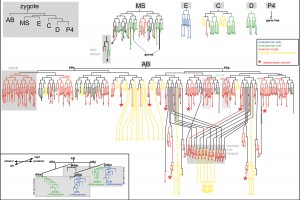
Sydney Brenner made several seminal contributions to the emerging field of molecular biology in the 1960s: e.g. the triplet nature of the DNA coding in 1961. As other scientists, he turned to the study of model organisms in the late 1960s. Brenner searched an organism matching his criteria: 1-A rapid life cycle allowing growth of large populations in a short period of time. 2- A simple reproductive cycle and genome. 3- A small size, for simple storage and to elucidate ultrastructural details by electron microscopy. He introduced Caenorhabditis elegans within the MRC-LMB in Cambridge, UK in 1963.
The “worm project” started by the establishment of the genetic wild type and creation of the first mutants using mutagens. Eventually, a “dumpy” individual was identified. The dumpy phenotype was due to an autosomal-recessive mutation in a collagen gene. From 1967 until the early 1970s, over 300 mutagen-induced mutations were identified; many of them affected behaviour, primarily resulting in worms that were defective in movement (“uncoordinated”). Brenner, S. (1974). The genetics of Caenorhabditis elegans. Genetics, 77, 71-94.
Aiming for the genetic dissection of the development and of the function of the nervous system. It soon became clear that the precise connections between neurons would ultimately be necessary to understand the relationship between the genetic “program” and the behaviour of the animal. By using serial electron micrograph sections it was possible to perfectly determine neural connectivity. This was done by John White together with Eileen Southgate, J. Nichol Thomson and Brenner. Completed in 1986, it was the first complete mapping of the architecture of a nervous system until 2025. C. elegans has 302 neurons and form a total of ~7,000 synapses throughout the hermaphrodite.
John Sulston, also in the LMB group soon took a similar track with the a comprehensive description of the developmental processes, observing and documenting the complete cell lineages of the worm. Purely descriptive biology projects soon opened revolutionary fields to the newly formed C. elegans community. Better knowledge of the cell lineages provided the basis for correlating mutations and developmental processes. During the worm development some cell appeared to enter in a programmed cell death, apoptosis. Robert Horvitz focused on this phenomenon and identified many of the genes involved in triggering apoptosis.
Better knowledge about the circuitry provided a tool to understand behavioural response to external cues like the mechanosensation. Martin Chalfie, identified the sensory machinery for touch, the touch neurons and the circuit involved. As the worms are transparent he soon applied the newly sequenced jellyfish Green Fluorescent Protein (GFP) to visualize them in 1994. GFP and its variant are now of common use to visualize cells and intracellular structures.
C. elegans can readily be made to accept foreign DNA or RNA by injection in the gonad. Although this is usually working fairly well, such experiments have outlined a number of concerted responses that recognize (and in most cases silence) the foreign nucleic acid. Andrew Fire and Craig Mello identified a mechanism of RNA silencing in C. elegans responding to double stranded RNA. Because only small numbers of dsRNA molecules were required for the observed effect, they proposed that a catalytic process was involved. This hypothesis led to the discovery of RNA interference (RNAi) and to RNAi knock-down screens.
Starting from a small group around Sydney Brenner in the 1970’s the worm community has expended so much that C. elegans is likely now the best-understood metazoan organism. The entire genome was sequenced in 1998. Around 18.000 genes are identified and 80% are conserved in human. For most of them, several mutants are available, the expression pattern are described, reagents are made available. By accelerating the forward genetic approach, the next generation sequencing open a new era for C. elegans genetics.
The initial interest in nervous system finally reached maturity with dozens of lab using C. elegans as a model to determine the principles governing nervous system development and function. It includes labs exploring How individual neuron types are specified and how these connect with the right partners. How genes and circuit generate behaviour. The genes involved in neuronal function such as neurosecretion or sensory function.
The Nobel Prize in Physiology or Medicine was awarded in 2002 to Sydney Brenner, H. Robert Horvitz and John Sulston for their work on C. elegans and the apoptosis and in 2006 to Andrew Fire and Craig C. Mello for their discovery of RNA interference. In 2008, Martin Chalfie shared a Nobel Prize in Chemistry for his work on green fluorescent protein (GFP).


